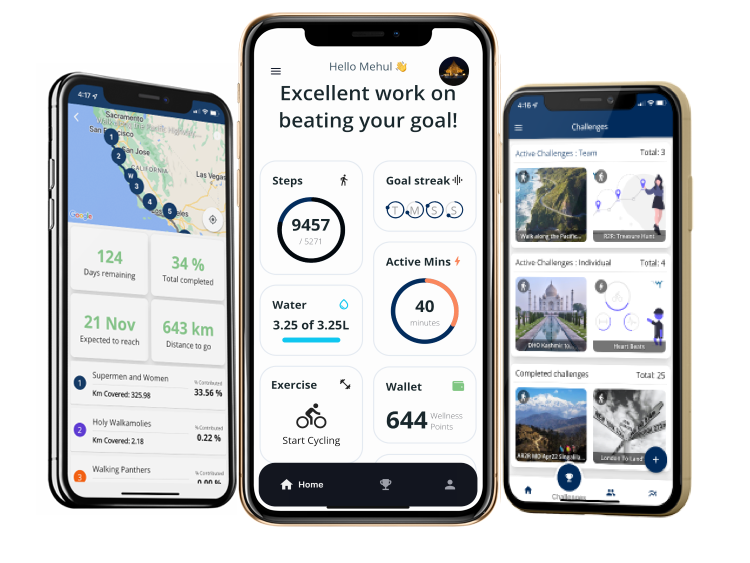Lawrence Bossidy, a well-respected leader at General Electric & later at Honeywell once said: “I am convinced that nothing we do is more important than hiring and developing people. At the end of the day, you bet on people, not strategies”.

While this may not sound surprising today, this thought was ahead of its time when he said it in the late 20th century. Conventional views at the time treated employees as the only working elements of the companies.
But now, companies are increasingly taking responsibility for the health and wellbeing of their people, and treating them as family, recognising that employees are their most valuable asset and have a right to expect that they will be cared for.
Whether you are looking to implement a brand new employee wellbeing strategy or overhaul an existing one that isn’t as effective, in this article we’ll cover some key elements of a successful employee wellbeing strategy.
The rise of digital technology & connectivity has changed the way organisations operate day-to-day. Adding to that, COVID-19 has forced businesses to adapt sooner & there is no turning back now. Fully remote or some form of the hybrid workplace is here to stay and therefore wellbeing plans & strategies need to be current with the times we are living in.
According to research by the Mental Health Index, mental stress among employees is at an all-time high – primarily due to the changes in the way we work. Employees are reporting feelings of isolation and anxiety which negatively impacts job satisfaction and productivity.
In addition, we are increasingly sedentary in our lives. Sitting at our desks for longer periods, staring at a screen with few breaks – leading to a plethora of issues, most notably, back & neck pains & overall impact to our quality of life.
This is a critical time for businesses to re-evaluate what’s working and what’s not in their employee wellbeing & engagement strategy.
Employee wellbeing is holistic. Key components are:
- Physical: Understaffing or urgent business can lead to a heavy workload. Employee lifestyle is becoming increasingly sedentary, leading to not enough physical activity. Providing incentives & implementing strategies to encourage & motivate employees to be physically active can go a long way in supporting their physical wellbeing.
- Mental: Stress is common in workplaces because of project deadlines, isolation, working pressures, etc. There are stresses outside of work too; pandemic restrictions, changing global political scenarios, etc. Support employees’ mental wellbeing by providing them access to coaching sessions, counselling services, and tools & solutions that help with meditation, mindfulness & resilience.
- Nutritional: Good eating & nutritional habits can positively impact employees and their productivity. Promotion of proper nutrition and eating habits is highly recommended. You can start simple by providing discounted consultations with nutritionists, ordering healthy food for in-office meals & catering, or even sending out new healthy recipes every week.
- Professional: Having clarity in career progression, fair pay, and access to resources that support growth are key to an employee feeling satisfied with their job. Communication, transparency & people management trainings for Managers is essential for employees feeling happy & satisfied at work. As they say: Employees don’t leave a bad company, they leave a poor manager.”
- Financial: Paying them fairly, encouraging participation in financial education programs, setting up pension plans, income protection, etc that can provide employees with peace of mind when it comes to financial wellbeing.
- Workplace culture: This entails getting to know what makes employees happy at work, improving the working environment, conducting social events and group activities, offering flexible work to improve work-life balance, and improving holiday and leave policies.

How can you execute a successful wellbeing strategy?
- Start simple, start small: There are a lot of drivers to employee wellbeing as we discussed above. As an HR Leader, this can feel overwhelming – but often, when there’s a lot to do – start by just starting somewhere. Create a simple plan, and start with one area of focus. Physical wellbeing is often a good starting point as it can be simple to get off the ground and also bring your team together in a team challenge.
- Build a plan around “focus” quarters: Not only is a holistic wellbeing strategy from day 1 overwhelming for HR leaders, but employees may also struggle to get value from it all at once. Explore the “focus quarter” strategy when you are starting out. This means for a quarter you focus on physical wellbeing, mental wellbeing in the next one, and so on. This keeps it fresh and makes it easy from an organisational and logistical perspective for both the HR teams & employees.
- Ask for employee feedback: Check in with employees regularly to understand what’s working and what’s not. Adoption stats are a good indicator of impact and efficacy, but they do not provide the full picture, especially as to why some employees did not sign up – could be an area of improvement for the strategy, solution or even communication. Anonymous employee pulse checks are very useful in creating a strategy that has the maximum impact for employees!
- Monitor adoption & impact: Create goals around adoption as well as the impact you envision. Just like with any other initiative, trial out strategies to improve adoption among employees. This can be communication frequency or having a wellbeing dashboard – different ways to get as much attention from employees as possible. Impact assessments can be very powerful, and require clear & attainable KPIs as well as benchmarking before & after intervention.
- Lead by example: Finally, for a successful wellbeing strategy, the Exec team needs to lead by example. Something as simple as the leadership talking about wellbeing regularly can go a long way in inspiring employees to do the same. This can be advantageous also in the way that the leadership understands the efficacy of a wellbeing strategy because they are actively participating in it.
There you go. In this article, we have talked about the various components of an employee wellbeing and share our tips and tricks on how to execute a successful wellbeing strategy in your company.
Implemented something similar or different? We’d love to hear from you & please share your comments below.
References & acknowledgements:
1. Future of Work is Wellbeing, Forbes
2. Employee wellbeing & Performance


No responses yet